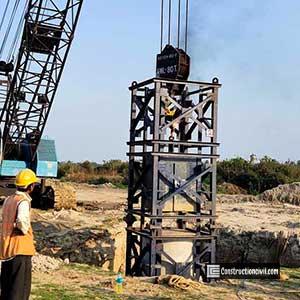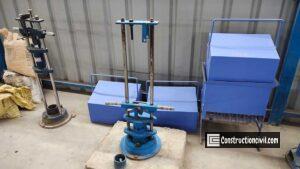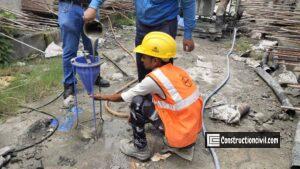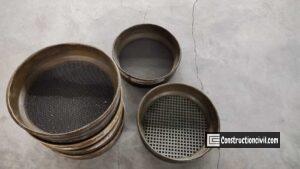Dynamic load test on piles is a method that can be used to evaluate pile load-carrying capacity by applying a dynamic load. The method is valid, reliable, and helps evaluate pile capacity quickly compared to static load tests, and one or more piles can be tested per day as per the requirement of the project. Dynamic load test for piles is conducted using Pile Driving Analyzer(PDA) to determine pile load capacity by collecting and analyzing force and velocity data under drop-weight impacts. The field data are further analyzed using Pile Wave Analysis to refine the soil parameter and assumptions.
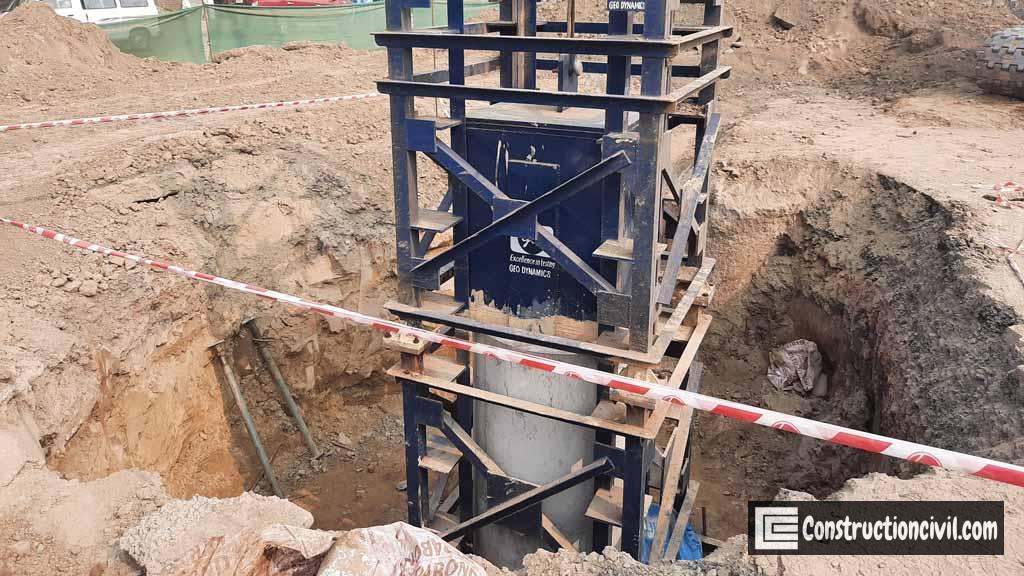
Also, Read: Vertical Pile Load Test Procedure – Kentledge Method
Objective: Dynamic Load Test on Piles
- Static pile capacity at the time of load testing.
- Simulated static load test curve
- Bearing capacity and skin friction
- Distribution pattern of skin friction along the pile shaft
- developed compressive stresses during testing
- Displacement of the test pile
- Pile integrity
Pile and Test Preparation:
- Dynamic load test on piles is carried out by fixing strain sensors and accelerometers to the sides of the test pile below 1.5 times of pile diameter or higher from the pile head top and then connecting them with PDA.
- Test pile should be extended to 1.6 times pile diameter after chipping top loose concrete.
- In the case of the liner pile, two openings(300mm x 300mm) shall be left below 1.5 times of pile diameter from the top of the pile head for sensor fixing.
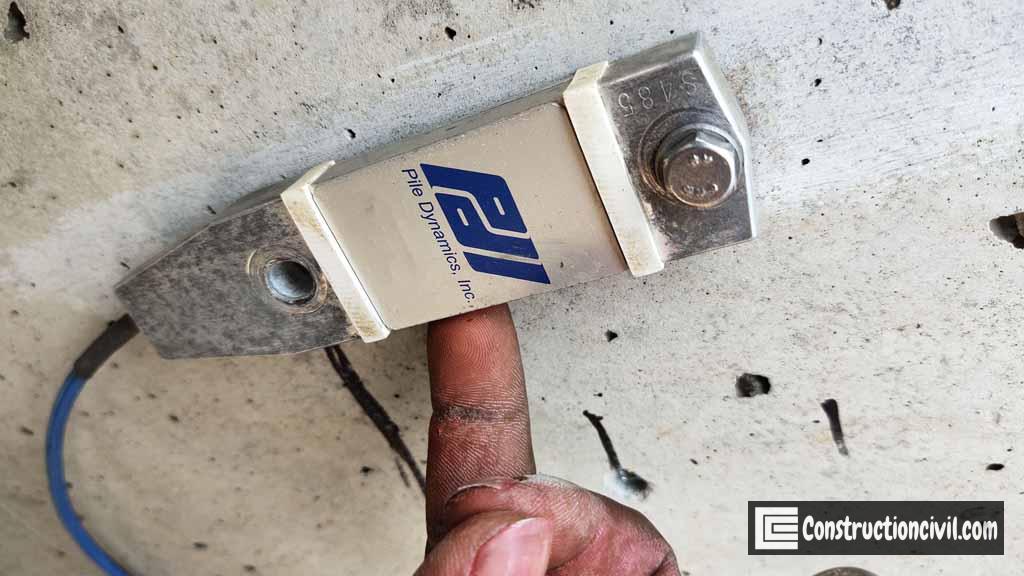
Also, Read: Lateral Load Test Pile – General Arrangement & Procedure
- The extended pile head diameter, reinforcement and grade of concrete should be the same as the actual pile. A higher grade of concrete mix can be used for pile head built up if required after special approval from the authority.
- Vertical and helical reinforcement shall also be extended to avoid cracking of concrete under hammer impact.
- A reinforcement mesh must be provided at the top of the pile reinforcement, as shown in the test pile drawing.
- Concrete at the sensor level shall be smooth, hard and uniform.
- It is necessary to ensure that the pile top has sound concrete, and it should be even and flat at the top. The pile sides also shall be reasonably uniform in diameter.
- After grinding, a flat surface is prepared to fix the sensors.
- Sometimes a pile top cushion consisting of sheets of plywood with a total thickness between 25mm to 50mm or as directed by the Test Engineer shall be placed on the top of the pile head before testing.
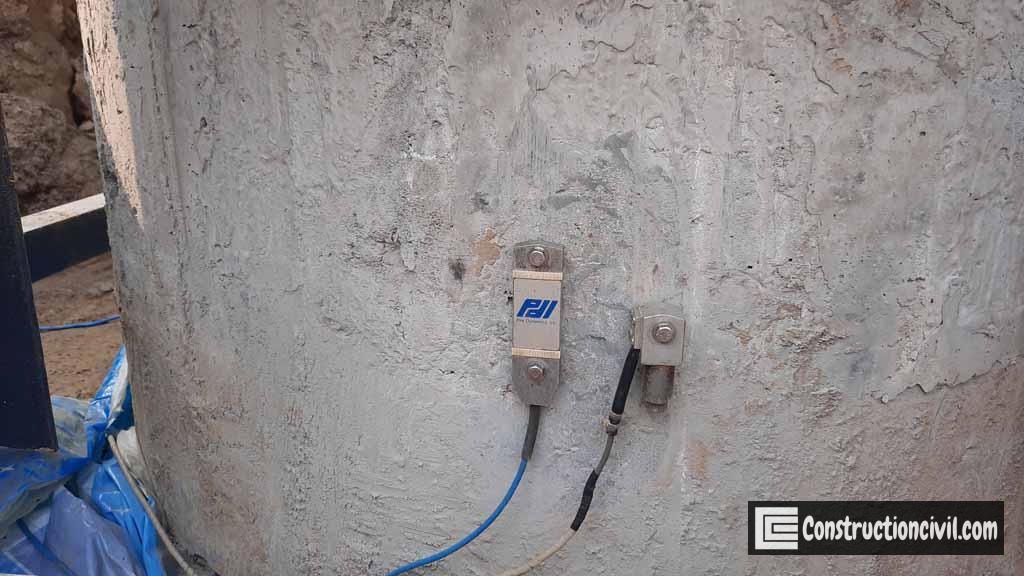
Also, Read: Integrity Test of Pile – Purposes, Procedure & Limitations
Pile Monitoring and Analysis:
- After 15 days of pile installation, a dynamic load test on piles may be carried out, providing the cube compressive strength of pile concrete and built-up portion concrete has achieved the required strength.
- High Strain dynamic load test for piles is conducted by fixing strain transducers and accelerometers to the sides of the pile shaft. The sensors, as mentioned above, are connected to the PDA through the main cable.
- First of all, sensors record strain and acceleration measurements and convert them from analogue to digital form and display them on PDA screens.
- Dynamic load test for piles is started by impacting the pile head with a hammer blow, starting with a smaller drop height (typically 0.5m). This is to ensure the correctness of the data and the setup arrangements.
- Each hammer blow, the strain transducers measure strains, whereas accelerations are measured by accelerometers connected on the other sides of the test pile.
- By integration, these signals are converted to digital form by the equipment and then converted to force and velocity.
- PDA displays immediate field results in the form of the mobilized capacity, pile top compression, integrity, stresses etc., are shown after each hammer blow.
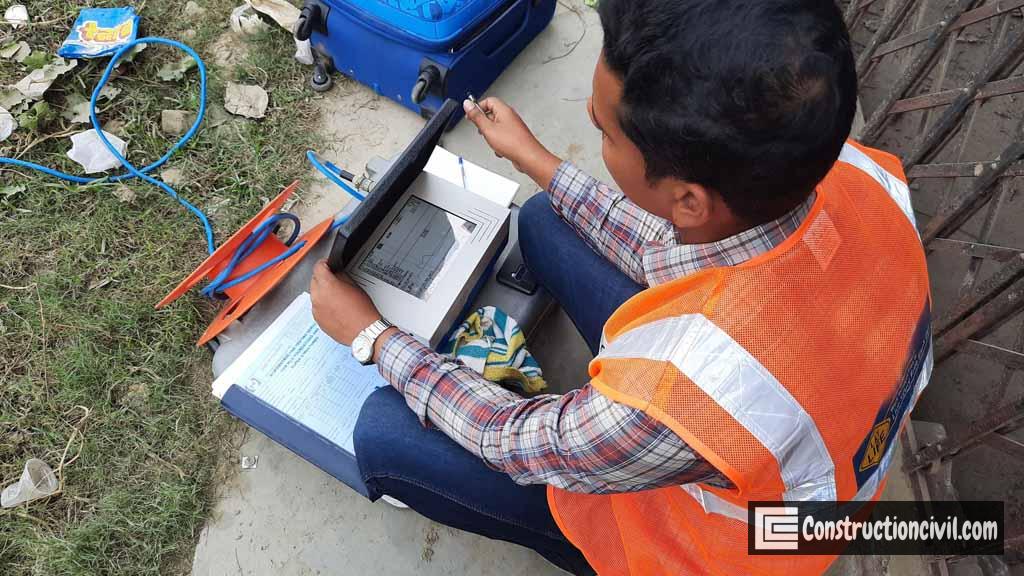
Also, Read: 4 Important Bentonite Test for Piling – Equipment & Procedure
- The force and velocity curve shall be as per ASTM D4945.
- Dynamic load test on piles is continued by increasing the hammer height by around 0.5m increments until either the pile set or the pile capacity reaches the required or limiting values.
- The limiting value for the pile capacity would be the test load at which settlement would be 3-4mm per blow. In other words, a test can be terminated when settlement is more than 3-4mm per blow.
- Generally, the pile capacity shall be considered fully mobilized if the energy levels due to hammer impact are enough to cause a measurable net displacement of at least 3-4mm per blow for a minimum of three successive impacts.
- Suppose the pile settlement is less than 3-4mm per blow and the pile achieves the required capacity. In that case, it implies that not all the static pile resistance has been mobilized and that the pile still has some capacity that could not be measured or was not required to be measured at the time of testing.
- After combining measured field data with the pile wave equation, an analytical method can predict the static bearing capacity of the test pile and the distribution of soil resistance.
- Recorded force and velocity data is straight input as obtained from field measurements.
- Depending on the measured velocity, the program computes the force required to cause the imposed velocity.
- Both measured and computed forces are plotted as a function of time.
- The interactive analysis is continued until a good match quality between both the curves is received.
- If the match quality is not satisfactory, the soil resistances at the pile point and along the pile shaft are adjusted until a good match is found.
- This provides a better judgment of the actual static pile capacity measured during the field dynamic load test on piles and the friction and end-bearing components.
- A good match is obtained when match quality is less than five tor bored piles. However, there may be exceptions that shall be acceptable when justifiable.
- A graphical printout can be obtained on-site, which shall include input and output quantities, the force/velocity response graph, the upward and downward wave time response graph, the static and dynamic resistance-time graph, the energy time and displacement time graph shall be presented along with the following key input and output results,
Input Parameters Dynamic Load Test on Piles:
- Pile No.
- Date and time of test
- The pile length below gauges (LE)
- The adopted pile wave speed at the pile head and the overall wave speed
- The wave return time (2L/c)
- The pile modulus at the transducer location
- The pile specific weight
- The pile area at the transducer location (AR)
- The pile impedance
- The Case Method damping factor(Jc)
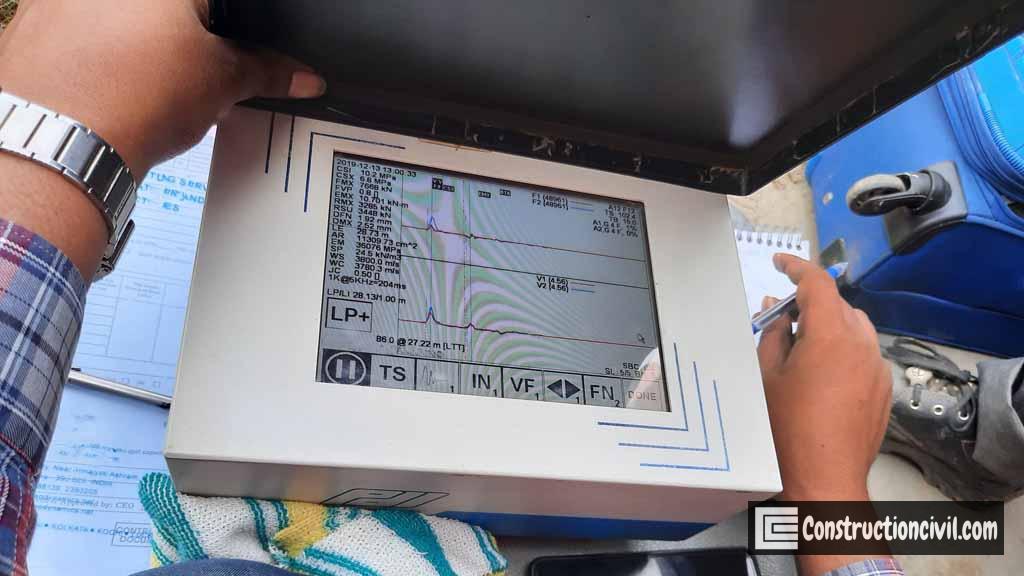
Also, Read: Bentonite Uses in Piling – Bentonite Slurry Preparation and Recycling
Output Parameters for Dynamic Load Test on Piles:
- The maximum force applied(FMX)
- The maximum energy imparted to the pile (EMX)
- The maximum displacement of the pile head (DMX)
- The pile capacity estimate(RMX, RSU)
- Force velocity proportionality(FVP)
- The maximum compressive stress in a pile (CSX)
- The maximum tensile stress in a pile (TSX)
- Estimated finalnile set(DEN)
The final report contains all aspects of pile monitoring. The report will incorporate the results of CAPWAP analysis and a plot of simulated static load test curve with all the output mentioned in the introduction that satisfies all the requirements of a standard dynamic load test on piles.
Limitation of Dynamic Load Test on Piles:
- Although the method can be used to predict skin friction and end bearing along the length of the pile, these values should be used with caution as the CAPWAP is an iterative procedure.
- Further, this separation also depends on pile geometry, reliability of soil bore log, and movement of the pile under repetitive impacts.
- Unlike static testing, the evaluation of dynamic pile test results requires an experienced engineer trained in interpreting the results.
Reference:
- ASTM D4945
Also, Read: Laboratory Test on soil – Procedures and Objective
